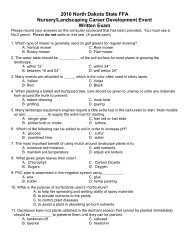Extemporaneous Speaking Contest - ND FFA
Extemporaneous Speaking Contest - ND FFA
Extemporaneous Speaking Contest - ND FFA
You also want an ePaper? Increase the reach of your titles
YUMPU automatically turns print PDFs into web optimized ePapers that Google loves.
<strong>Contest</strong>ant NameOral Communication – 60 pointsIndicatorsA. Examples5B. <strong>Speaking</strong>withouthesitation10C. Tone10D. Beingdetailoriented10E. Connectingandarticulatingfacts andissues10F. <strong>Speaking</strong>unrehearsed(questions &answers)15Score Card <strong>Extemporaneous</strong> <strong>Speaking</strong>DEPARTEMENT OF CAREER A<strong>ND</strong> TECHNICAL EDUCATIONSFN 15023 (8/12)Very strong evidence skillis present5-4Examples are vivid, preciseand clearly explained.• Examples are original,logical and relevant.5-4Speaks very articulatelywithout hesitation.• Never has the needfor unnecessary pausesor hesitation whenspeaking.10-8Appropriate tone is consistent.• Speaks at the rightpace to be clear.• Pronunciation ofwords is very clearand intent isapparent.10-8Is able to stay fully detailoriented.• Always providesdetails which supportthe issue; is wellorganized.10-8Exemplary in connectingfacts and issues and articulatinghow they impactthe issue locally and globally.• Possesses a strongknowledge base andis able to effectivelyarticulate informationregarding relatedfacts and currentissues.10-8Speaks unrehearsed withcomfort and ease.• Is able to speakquickly with organizedthoughts andconcise answers.15-11Moderate evidence skill ispresent3-2Examples are usuallyconcrete, sometimes needsclarification.• Examples are effective,but need moreoriginality orthought. 3-2Speaks articulately, butsometimes hesitates.• Occasionally has theneed for a long pauseor moderate hesitationwhen speaking.7-4Appropriate tone is usuallyconsistent.• Speaks at the rightpace most of thetime, but shows somenervousness.• Pronunciation ofwords is usuallyclear, sometimesvague. 7-4Is mostly good at beingdetail-oriented.• Usually providesdetails which aresupportive of theissue; displays goodorganizational skills.7-4Sufficient in connectingfacts and issues and articulatinghow they impactthe issue locally and globally.• Possesses a goodknowledge base andis able to, for themost part, articulateinformation regardingrelated facts andcurrent issues.7-4Speaks unrehearsed mostlywith comfort and ease,but sometimes seemsnervous or unsure.• Is able to speak effectively,has to stopand think and sometimesgets off focus.10-6ChapterStrong evidence skill is notpresent1-0Examples are abstract or notclearly defined.• Examples are sometimesconfusing, leavingthe listeners with questions.1Speaks articulately, but frequentlyhesitates.• Frequently hesitates orhas long, awkwardpauses while speaking.3-0Has difficulty using an appropriatetone.• Pace is too fast; nervous.• Pronunciation of wordsis difficult to understand;unclear.3-0Has difficulty being detailoriented.• Sometimes overlooksdetails that could bevery beneficial to theissue; lacks organization.3-0Has difficulty with connectingfacts and issues and articulatinghow they impact theissue locally and globally.• Possesses someknowledge base but isunable to articulateinformation regardingrelated facts and currentissues.3-0Shows nervousness or seemsunprepared when speakingunrehearsed.• Seems to ramble orspeaks before thinking.5-0RankPointsEarnedJudges’ CommentsOVER
Non-verbal Communication – 40 pointsA. Attention(eye contact)10B. Mannerisms10C. Gestures10D. Well-poised10General Comments:Eye contact constantlyused as an effective connection.• Constantly looks atthe entire audience(90-100% of thetime).10-8Does not have distractingmannerisms that affecteffectiveness.• No nervous habits.10-8Gestures are purposefuland effective.• Hand motions areexpressive and usedto emphasize talkingpoints.• Great posture(confident) with positivebody language.10-8Is extremely well-poised.• Poised and in controlat all times.10-8Eye contact is mostlyeffective and consistent.• Mostly looks aroundthe audience (60-80%of the time).7-4Eye contact does not alwaysallow connection with thespeaker.• Occasionally looks atsomeone or some groups(less than 50% of thetime).3-0Sometimes has distracting Has mannerisms that pull frommannerisms that pull from the effectiveness of the presentation.the presentation.• Sometimes exhibitsnervous habits orticks.7-4• Displays some nervoushabits – fidgets or anxiousticks.3-0Usually uses purposefulgestures.• Hands are sometimesused to express oremphasize.• Occasionally slumps;sometimes negativebody language.7-4Usually is well-poised.• Poised and in controlmost of the time;rarely loses composure.7-4Occasionally gestures are usedeffectively.• Hands are not used toemphasize talking points;hand motions are sometimesdistracting.• Lacks positive body language;slumps.3-0Isn’t always well-poised.• Sometimes seems to losecomposure.3-0Gross Total PointsDeductionsNet Total Points(100 Points Possible)PointsEarnedJudges’ Comments1 point per 10 seconds under 4 min or over 6 min3:50-3:59= -1pt 6:01-6:10= -13:40-3:49= -2pt 6:11-6:20= -23:30-3:39= -3pt 6:21-6:30= -33:20-3:29= -4pt 6:31-6:40= -43:10-3:19= -5pt3:00-3:09= -6pt
















